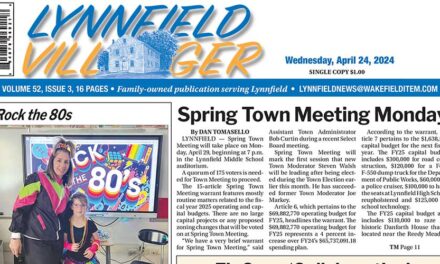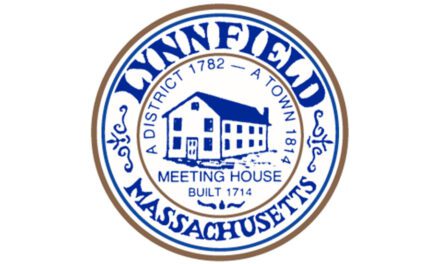By MAUREEN DOHERTY
LYNNFIELD — The town will maintain its classified tax rate for fiscal year 2015 following a 2-1 vote of the Board of Selectmen Nov. 24.
The tax rate will decrease slightly for residential property owners by 28 cents to $14.49 per thousand. This represents a decrease of 1.9 percent over the current residential rate of $14.77. Over the past two years the residential tax rate has decreased by a combined 33 cents per thousand.
However, the overall tax bill will also rise modestly in FY’15 due to a 4.3 percent increase in residential property values. This means the average homeowner will pay $179 more in taxes than they did last year or a total of $7,989 on the average single-family home valued at $551,355.
With the classified or “split” tax rate, owners of commercial, industrial and personal property, known as CIP, will see their tax rate increase by 69 cents per $1,000 to $17.28, an increase of 4.2 percent.
This means the tax bill for a business with an average valuation of $1.6 million will increase by $624 to $27,830.
The average value of the 134 CIP parcels cited in figures provided by Town Administrator Bill Gustus has decreased by 1.8 percent in the past year, from $1,639,931 in FY’14 to $1,609,630 in FY’15. Over the past two years the CIP tax rate has increased by 98 cents per thousand.
Both tax rates reflect less than the 2.5 percent the maximum increase in the levy allowed under Propositions 2 ½. The residential rate will increase by 2.28 percent and the CIP rate will increase by 2.29 percent in FY’15.
These tax rates were certified by the state Dept. of Revenue (DOR) on Monday.
Assessing Manager Dick Simmons gave a thorough overview of the process his department goes through each year to conduct the revaluation of the properties in town and provide details on the potential levy shift and its effect on typical residential and commercial values at last week’s public hearing. The selectmen must vote annually to either retain the classified tax rate or opt for a single tax rate for all taxpayers.
“For us it is a mathematical process. Very simply one of the first questions is: ‘Do we want to give benefit to the residential property owners over commercial property owners or do we want to keep it on an even basis – that they both raise at the same rate?’” Simmons said.
Town Administrator Bill Gustus recommended that the selectmen continue to classify the tax rate just as the town has done during the past decade “not so much to hit either the residential or the commercial class with more taxes than might be fair or to give the residents a break but rather to equalize the effect of the tax bills across all classes,” Gustus said.
“Residential and business properties do not appreciate or depreciate at the same rates every year,” Gustus explained, adding, “If taxes are going to go up, the percent by which they go up should be the same. We shift the rates back and forth annually based upon fluctuations in values and to come up with a result where we have a uniform increase in tax bills. This does not necessarily mean that the tax rates are the same; in fact, they vary dramatically from year to year.”
The bottom line for all taxpayers means that year to year they will see the same percentage increase in their tax bills based on the average values of commercial and residential properties, he said.
By contrast, if the town returned to a single tax rate this year, Gustus said, “residential taxpayers would incur a 4.8 percent increase and commercial/industrial and personal property would see a decrease of 12 percent because in the prior year we classified the rate. … That would be legal but I don’t think it would be fair.”
Selectman Phil Crawford agreed with Gustus that the town should maintain the existing classified tax rate so that all tax classes “pay equally for the new tax levy we need.”
“We do not want to shift any more of the tax burden (onto residences) otherwise you give the businesses a tremendous tax break,” Crawford said as he moved to adopt a classification factor of 1.164, as recommended by Gustus.
Selectmen Chairman Dave Nelson agreed that this formula has worked well for the town over the last 10 years. “It is a fair way to split the tax, so I also think that is a good way to go based upon what is laid out before us,” he said.
Selectman Tom Terranova favored an even lower tax rate for residential property owners, which would shift the differential from just over 16 percent as proposed by Gustus to about 30 percent.
“I think with MarketStreet being here a lot of people are looking for more of a shift. They’re seeing a lot more issues because of MarketStreet and I think we should try to give them a flat tax. We shouldn’t be looking at any kind of an increase,” Terranova said.
Terranova said he understood the theory behind maintaining the same 2.3 percent tax increase for both classes of property. “I’d like to see the residential rate remain flat. It looks like it is not a huge differential. My quick calculations came out to $14.17 per $1,000 versus $14.49. But I’d like to see the residential tax rate set at $14.17.”
Terranova noted that based on the chart compiled by Simmons, his proposed shift would necessitate a commercial rate of about $19.30 per thousand versus the $17.28 proposed.
“It is not a dramatic change but it is a change nonetheless and I think the homeowners would welcome that much more,” Terranova said.
Simmons offered some perspective on the impact that an additional $2.02 increase would have on some small businesses in town, particularly at the town’s one large office park where the units are individually owned condominiums. “They would receive a dramatic increase in their taxes,” Simmons said.
Terranova’s proposal did not draw a second. Crawford’s original motion for the 1.164 classification factor was seconded by Nelson and passed 2-1 with Terranova opposed. By law, the selectmen adopt the classification factor, which is then certified by the DOR and the tax rate is calculated from that factor.
Total property value tops $2.6 billion
According to Simmons, the town’s residential property valuation for FY’15 has been certified at $2,288,137,880. This represents 87 percent of the town’s taxable property, which is a decrease of 4 percent over last year’s valuation.
Although the percentage of residential property has decreased, the value of the town’s residential properties has increased by $121,686,880 over FY’14. There are currently 3,835 single-family homes in town.
The town’s CIP valuation has been certified at $335,087,935 for FY’15, which represents 13 percent of the town’s valuation, an increase of 4 percent over last year.
The value of the town’s combined residential and CIP property is $2,623,225,815, which allows the town to have a maximum tax levy of $38,954,903, or an increase of $3,305,060 over FY’14, according to figures prepared by the assessing office.
MarketStreet accounts for 76 percent of new growth
Simmons provided an overview of the town’s new growth figure from both residential and commercial properties, which totaled $2,505,994. Simmons said it is significant that 76.29 percent of all new growth in town during the past year is “attributable to MarketStreet.”
New growth in commercial property values totaled $1,857,667, with 74.13 percent of that increase due to expansion at MarketStreet. New growth in personal property, such as the computers used by businesses, totaled $123,138 and of that figure, 44 percent of it is due to MarketStreet, Simmons reported.
On the residential side of new growth figures, $222,423 came from new homes, $171,329 from condominiums at Windsor Estates, $130,168 from apartment buildings at ArborPoint (MarketStreet), $452 from two- and three-family homes and $817 from miscellaneous sources.
Vote against special tax exemptions
The selectmen voted unanimously against establishing a residential tax exemption that would have shifted the burden from lower valued owner-occupied properties to higher valued properties that are not the principal residence of a taxpayer. This provision of the state law is more advantageous in communities that have a lot of seasonal homes or rental properties.
The board also voted 3-0 against establishing a small commercial tax exemption intended to benefit small business parcels valued at less than $1 million that also employ fewer than 10 people. The way this law is written it would have little benefit locally and there is no requirement that the tax savings be passed on to the business owners who rent or lease their space as it is a tax break given to the property owners directly. The board is required to vote on these two exemptions annually.




